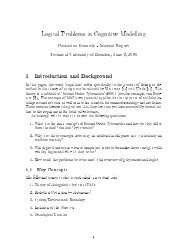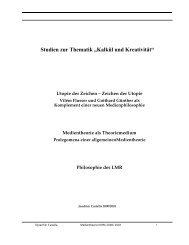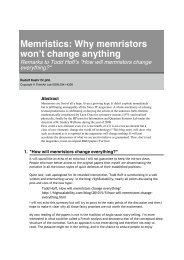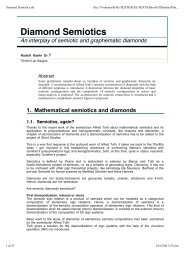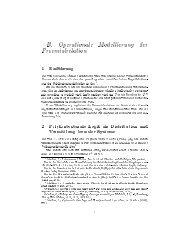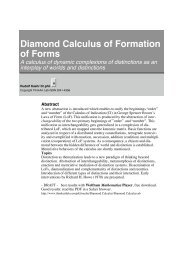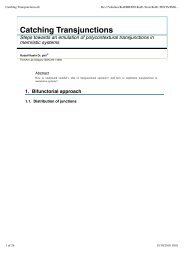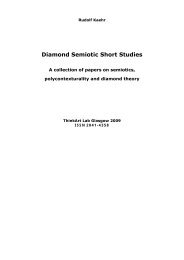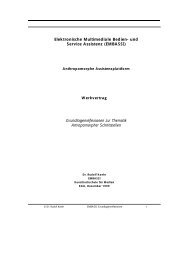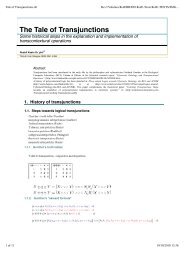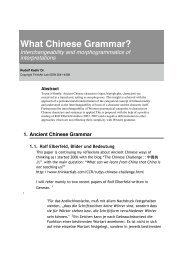Toth's semiotic diamonds - ThinkArt Lab!
Toth's semiotic diamonds - ThinkArt Lab!
Toth's semiotic diamonds - ThinkArt Lab!
You also want an ePaper? Increase the reach of your titles
YUMPU automatically turns print PDFs into web optimized ePapers that Google loves.
12 <strong>Toth's</strong> Semiotics.nb<br />
1. A 3 = @a Î b Î , aD ï A 4 = @ba, a Î D = @ba a Î D<br />
2. B 3 = @id1, bD ï B 4 = @id1, b Î D = @id1 b Î D<br />
INVERSION INV<br />
ad1. INV H@a Î b Î , aDL = INV H@INV H@a Î b Î DL, INV H@aDL<br />
= @INV H@aDL, INV H@a Î b Î DL<br />
= @@a Î D, @baDD = @a Î , baD = @a Î öbaD = A 4<br />
ad2. INV H@id1, bDL<br />
= INV H@INV Hid1L, INV HbLDL<br />
= @INV HbL, INV Hid1LD<br />
= @b Î , id1D = @b Î ö id1D = B 4<br />
„ Example2<br />
H3.1 µ 2.1 µ 1.3L<br />
AAb Î , id1E, @a Î , baDE<br />
Aa, a Î b Î E o @b, id1D<br />
AAa, a Î b Î E, @b, id1DE<br />
H1.3 µ 2.1 µ 3.1L<br />
1. A 3 = @a, a Î b Î D ï A 4 = @a Î , baD = @a Î baD<br />
2. B 3 = @b, id1D ï B 4 = @b Î , id1D = @b Î id1D<br />
INVERSION INV<br />
ad1. INV@a, a Î b Î D = @a Î , baD<br />
= INV HINV@aD, INV@ a Î b Î DL<br />
= INV@a Î b Î D, INV@aD<br />
= @@baD, a Î D = @ba, a Î D = @baöa Î D = A 4<br />
ad2. INV@b, id1D<br />
= @b Î , id1D<br />
= INV@INV HbL Ø INV Hid1LD<br />
= @INV Hid1L Ø INV HbLD<br />
= @id1 Ø b Î D = B 4<br />
Are Toth’s hetero-morphism and <strong>semiotic</strong> <strong>diamonds</strong> the same constructs or constructs in the same spirit as the diamond<br />
categories introduced by my own intuitions? What could the difference be? And how could such a possible difference<br />
matter?<br />
Toth’s construction is considering the complementarity between acceptional and rejectional morphisms based on inversion<br />
(INV) and chiastic exchange.<br />
This corresponds to some sketches I produced myself. But I conceived them as abbreviations of the difference based<br />
constructions.<br />
"Compositions as well as sautisitions (jump-operations) are ruled by identity and associativity laws. Complementarity<br />
between categories and saltatories, i.e., between acceptional and rejectional domains of <strong>diamonds</strong>, are ruled by difference<br />
operations.” (Kaehr, p.3)



